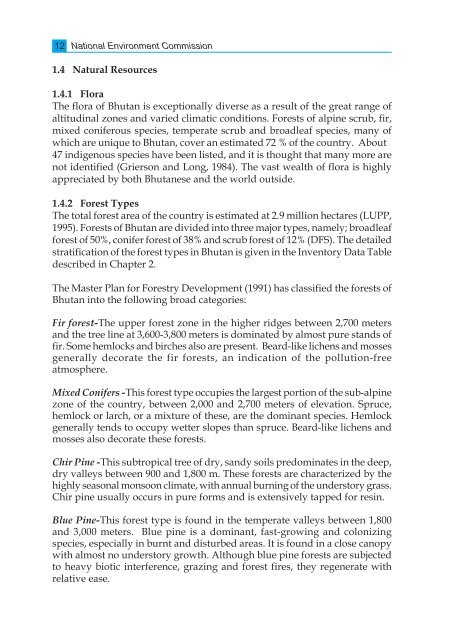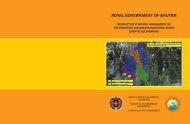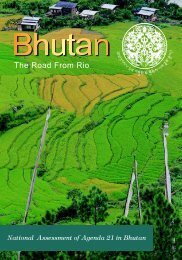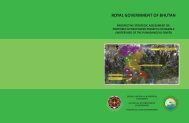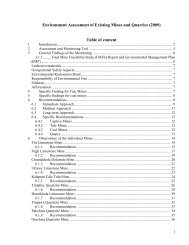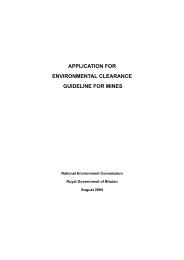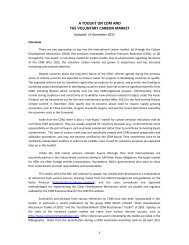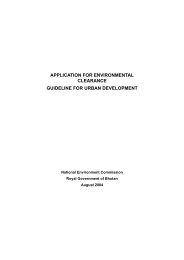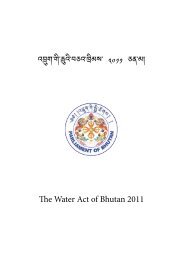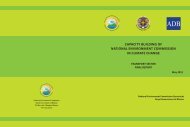Initial National Communication, under UNFCCC, September 2000
Initial National Communication, under UNFCCC, September 2000
Initial National Communication, under UNFCCC, September 2000
Create successful ePaper yourself
Turn your PDF publications into a flip-book with our unique Google optimized e-Paper software.
12 <strong>National</strong> Environment Commission<br />
1.4 Natural Resources<br />
38<br />
1.4.1 Flora<br />
The flora of Bhutan is exceptionally diverse as a result of the great range of<br />
altitudinal zones and varied climatic conditions. Forests of alpine scrub, fir,<br />
mixed coniferous species, temperate scrub and broadleaf species, many of<br />
which are unique to Bhutan, cover an estimated 72 % of the country. About<br />
47 indigenous species have been listed, and it is thought that many more are<br />
not identified (Grierson and Long, 1984). The vast wealth of flora is highly<br />
appreciated by both Bhutanese and the world outside.<br />
1.4.2 Forest Types<br />
The total forest area of the country is estimated at 2.9 million hectares (LUPP,<br />
1995). Forests of Bhutan are divided into three major types, namely; broadleaf<br />
forest of 50%, conifer forest of 38% and scrub forest of 12% (DFS). The detailed<br />
stratification of the forest types in Bhutan is given in the Inventory Data Table<br />
described in Chapter 2.<br />
The Master Plan for Forestry Development (1991) has classified the forests of<br />
Bhutan into the following broad categories:<br />
Fir forest-The upper forest zone in the higher ridges between 2,700 meters<br />
and the tree line at 3,600-3,800 meters is dominated by almost pure stands of<br />
fir. Some hemlocks and birches also are present. Beard-like lichens and mosses<br />
generally decorate the fir forests, an indication of the pollution-free<br />
atmosphere.<br />
Mixed Conifers -This forest type occupies the largest portion of the sub-alpine<br />
zone of the country, between 2,000 and 2,700 meters of elevation. Spruce,<br />
hemlock or larch, or a mixture of these, are the dominant species. Hemlock<br />
generally tends to occupy wetter slopes than spruce. Beard-like lichens and<br />
mosses also decorate these forests.<br />
Chir Pine -This subtropical tree of dry, sandy soils predominates in the deep,<br />
dry valleys between 900 and 1,800 m. These forests are characterized by the<br />
highly seasonal monsoon climate, with annual burning of the <strong>under</strong>story grass.<br />
Chir pine usually occurs in pure forms and is extensively tapped for resin.<br />
Blue Pine-This forest type is found in the temperate valleys between 1,800<br />
and 3,000 meters. Blue pine is a dominant, fast-growing and colonizing<br />
species, especially in burnt and disturbed areas. It is found in a close canopy<br />
with almost no <strong>under</strong>story growth. Although blue pine forests are subjected<br />
to heavy biotic interference, grazing and forest fires, they regenerate with<br />
relative ease.


